Strategic Analysis of Siemens Wind Power: Competitive Strategy Report
VerifiedAdded on 2020/03/04
|20
|5322
|29
Report
AI Summary
This report provides a comprehensive analysis of Siemens Wind Power's competitive strategy. It begins with an executive summary and introduction to Siemens, highlighting its role in the renewable energy sector. The report examines macro factors driving growth in renewable energy, including global warming, government subsidies, and international agreements like the Paris Agreement. It delves into Siemens Wind Power's unique selling points, market entry strategies, and the reasons for both onshore and offshore wind power investments. Using Porter's Five Forces and the BCG Matrix, the report analyzes the competitive landscape and Siemens' strategic positioning. It provides conclusions and recommendations, focusing on cost reduction, innovation, and market expansion, especially in BRICS nations. The report also includes an analysis of the current market trends in renewable energy, the impact of carbon trading and the rise of electric vehicles. The report emphasizes the need for Siemens to adapt to the changing market dynamics, innovate and focus on strategic expansion in the renewable energy market.
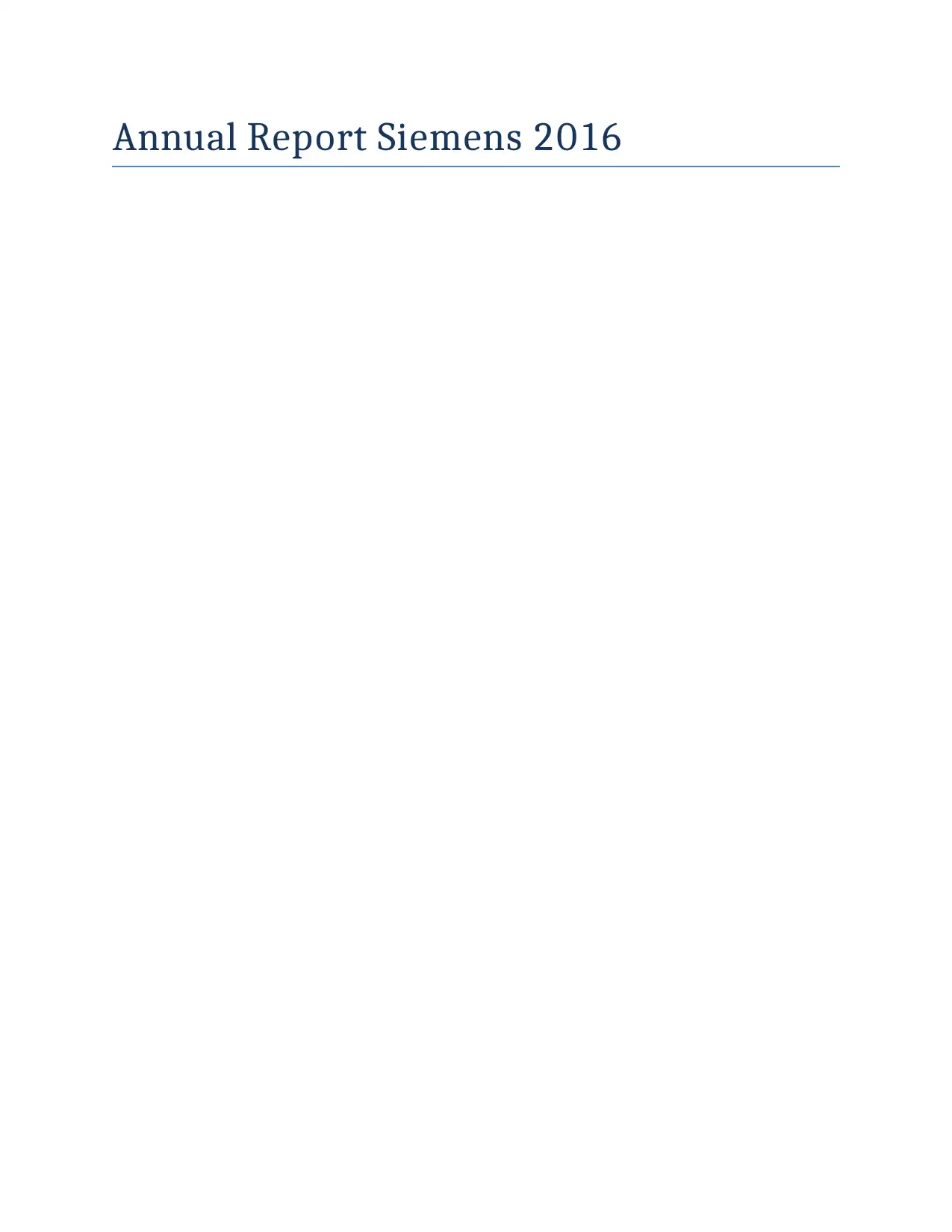
Annual Report Siemens 2016
Paraphrase This Document
Need a fresh take? Get an instant paraphrase of this document with our AI Paraphraser
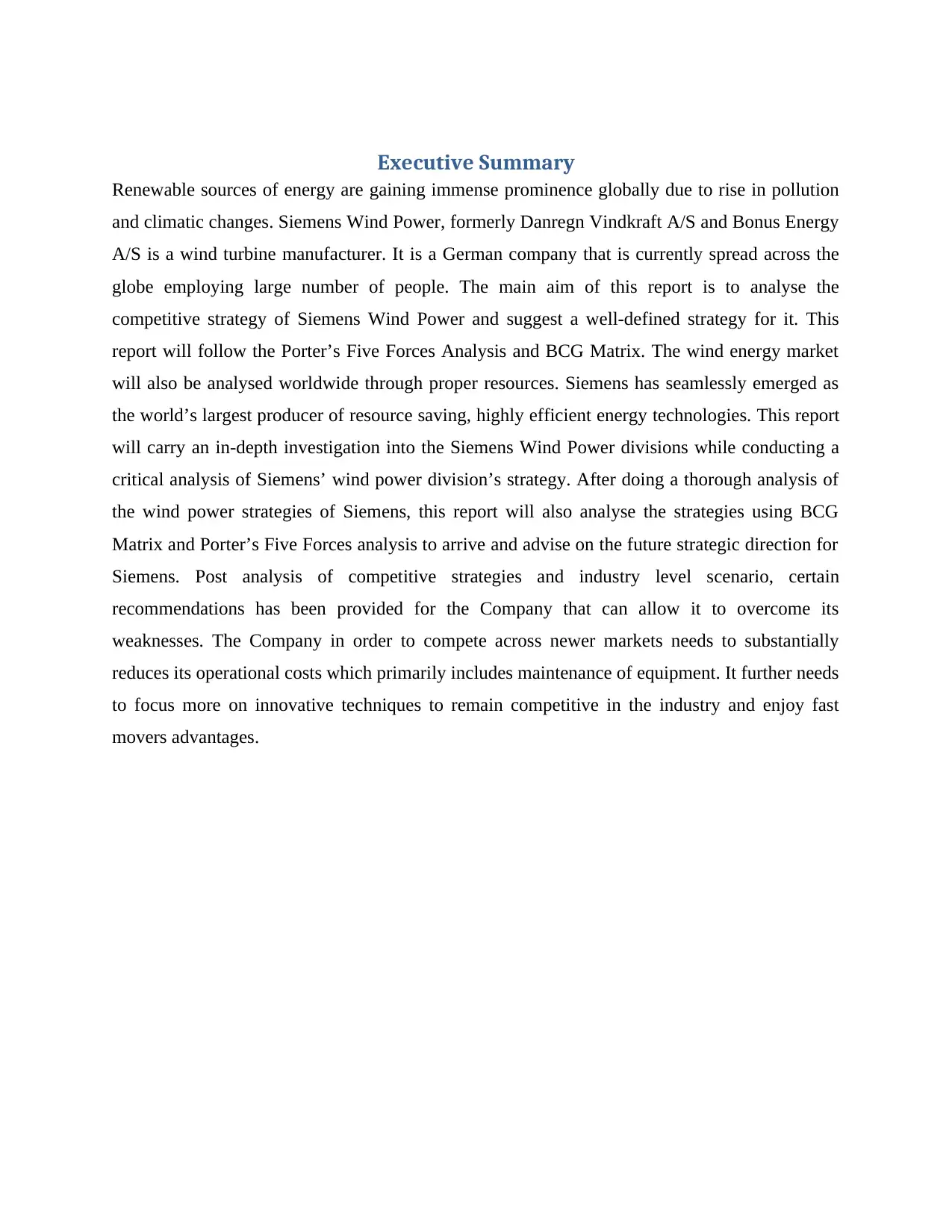
Executive Summary
Renewable sources of energy are gaining immense prominence globally due to rise in pollution
and climatic changes. Siemens Wind Power, formerly Danregn Vindkraft A/S and Bonus Energy
A/S is a wind turbine manufacturer. It is a German company that is currently spread across the
globe employing large number of people. The main aim of this report is to analyse the
competitive strategy of Siemens Wind Power and suggest a well-defined strategy for it. This
report will follow the Porter’s Five Forces Analysis and BCG Matrix. The wind energy market
will also be analysed worldwide through proper resources. Siemens has seamlessly emerged as
the world’s largest producer of resource saving, highly efficient energy technologies. This report
will carry an in-depth investigation into the Siemens Wind Power divisions while conducting a
critical analysis of Siemens’ wind power division’s strategy. After doing a thorough analysis of
the wind power strategies of Siemens, this report will also analyse the strategies using BCG
Matrix and Porter’s Five Forces analysis to arrive and advise on the future strategic direction for
Siemens. Post analysis of competitive strategies and industry level scenario, certain
recommendations has been provided for the Company that can allow it to overcome its
weaknesses. The Company in order to compete across newer markets needs to substantially
reduces its operational costs which primarily includes maintenance of equipment. It further needs
to focus more on innovative techniques to remain competitive in the industry and enjoy fast
movers advantages.
Renewable sources of energy are gaining immense prominence globally due to rise in pollution
and climatic changes. Siemens Wind Power, formerly Danregn Vindkraft A/S and Bonus Energy
A/S is a wind turbine manufacturer. It is a German company that is currently spread across the
globe employing large number of people. The main aim of this report is to analyse the
competitive strategy of Siemens Wind Power and suggest a well-defined strategy for it. This
report will follow the Porter’s Five Forces Analysis and BCG Matrix. The wind energy market
will also be analysed worldwide through proper resources. Siemens has seamlessly emerged as
the world’s largest producer of resource saving, highly efficient energy technologies. This report
will carry an in-depth investigation into the Siemens Wind Power divisions while conducting a
critical analysis of Siemens’ wind power division’s strategy. After doing a thorough analysis of
the wind power strategies of Siemens, this report will also analyse the strategies using BCG
Matrix and Porter’s Five Forces analysis to arrive and advise on the future strategic direction for
Siemens. Post analysis of competitive strategies and industry level scenario, certain
recommendations has been provided for the Company that can allow it to overcome its
weaknesses. The Company in order to compete across newer markets needs to substantially
reduces its operational costs which primarily includes maintenance of equipment. It further needs
to focus more on innovative techniques to remain competitive in the industry and enjoy fast
movers advantages.
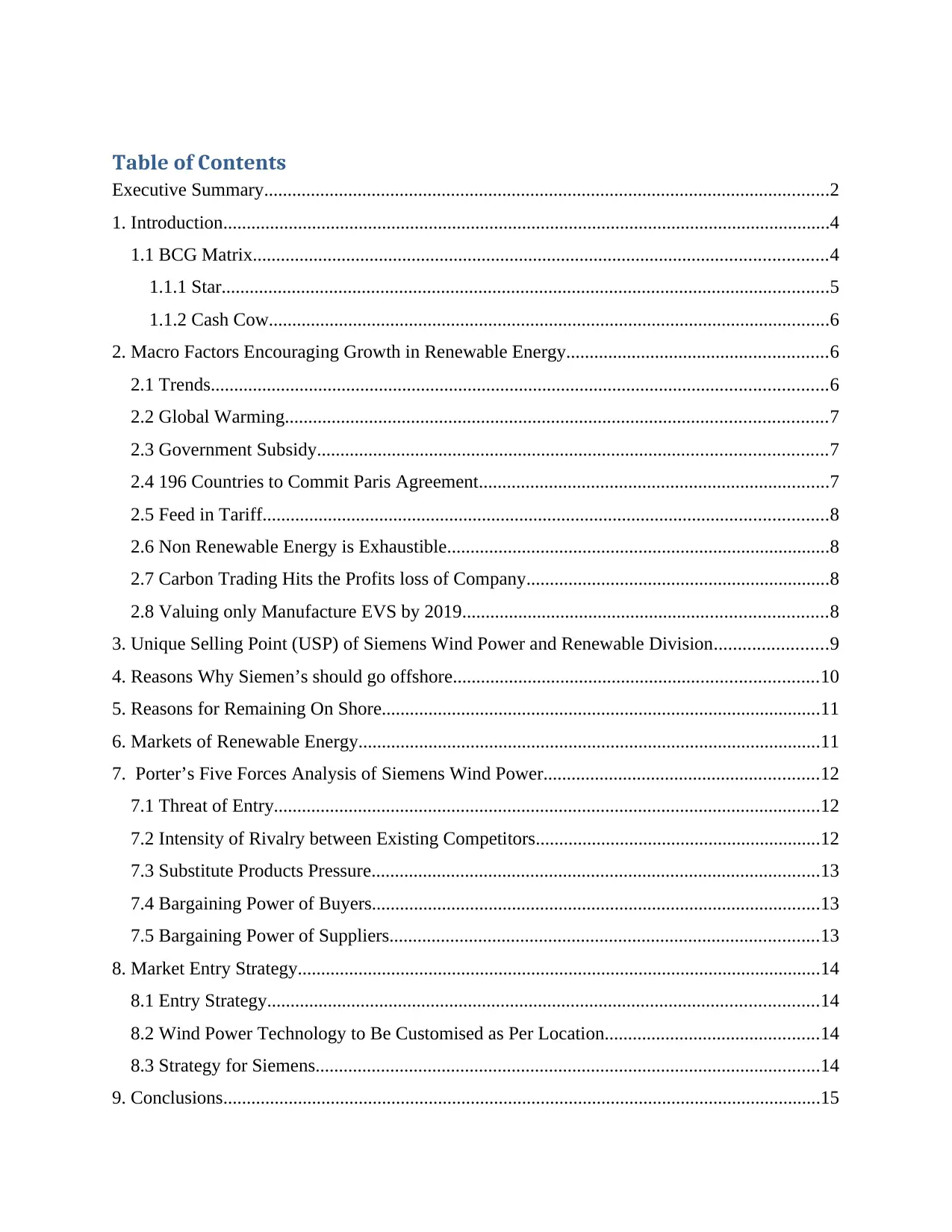
Table of Contents
Executive Summary.........................................................................................................................2
1. Introduction..................................................................................................................................4
1.1 BCG Matrix...........................................................................................................................4
1.1.1 Star..................................................................................................................................5
1.1.2 Cash Cow........................................................................................................................6
2. Macro Factors Encouraging Growth in Renewable Energy........................................................6
2.1 Trends....................................................................................................................................6
2.2 Global Warming....................................................................................................................7
2.3 Government Subsidy.............................................................................................................7
2.4 196 Countries to Commit Paris Agreement...........................................................................7
2.5 Feed in Tariff.........................................................................................................................8
2.6 Non Renewable Energy is Exhaustible..................................................................................8
2.7 Carbon Trading Hits the Profits loss of Company.................................................................8
2.8 Valuing only Manufacture EVS by 2019..............................................................................8
3. Unique Selling Point (USP) of Siemens Wind Power and Renewable Division........................9
4. Reasons Why Siemen’s should go offshore..............................................................................10
5. Reasons for Remaining On Shore..............................................................................................11
6. Markets of Renewable Energy...................................................................................................11
7. Porter’s Five Forces Analysis of Siemens Wind Power...........................................................12
7.1 Threat of Entry.....................................................................................................................12
7.2 Intensity of Rivalry between Existing Competitors.............................................................12
7.3 Substitute Products Pressure................................................................................................13
7.4 Bargaining Power of Buyers................................................................................................13
7.5 Bargaining Power of Suppliers............................................................................................13
8. Market Entry Strategy................................................................................................................14
8.1 Entry Strategy......................................................................................................................14
8.2 Wind Power Technology to Be Customised as Per Location..............................................14
8.3 Strategy for Siemens............................................................................................................14
9. Conclusions................................................................................................................................15
Executive Summary.........................................................................................................................2
1. Introduction..................................................................................................................................4
1.1 BCG Matrix...........................................................................................................................4
1.1.1 Star..................................................................................................................................5
1.1.2 Cash Cow........................................................................................................................6
2. Macro Factors Encouraging Growth in Renewable Energy........................................................6
2.1 Trends....................................................................................................................................6
2.2 Global Warming....................................................................................................................7
2.3 Government Subsidy.............................................................................................................7
2.4 196 Countries to Commit Paris Agreement...........................................................................7
2.5 Feed in Tariff.........................................................................................................................8
2.6 Non Renewable Energy is Exhaustible..................................................................................8
2.7 Carbon Trading Hits the Profits loss of Company.................................................................8
2.8 Valuing only Manufacture EVS by 2019..............................................................................8
3. Unique Selling Point (USP) of Siemens Wind Power and Renewable Division........................9
4. Reasons Why Siemen’s should go offshore..............................................................................10
5. Reasons for Remaining On Shore..............................................................................................11
6. Markets of Renewable Energy...................................................................................................11
7. Porter’s Five Forces Analysis of Siemens Wind Power...........................................................12
7.1 Threat of Entry.....................................................................................................................12
7.2 Intensity of Rivalry between Existing Competitors.............................................................12
7.3 Substitute Products Pressure................................................................................................13
7.4 Bargaining Power of Buyers................................................................................................13
7.5 Bargaining Power of Suppliers............................................................................................13
8. Market Entry Strategy................................................................................................................14
8.1 Entry Strategy......................................................................................................................14
8.2 Wind Power Technology to Be Customised as Per Location..............................................14
8.3 Strategy for Siemens............................................................................................................14
9. Conclusions................................................................................................................................15
⊘ This is a preview!⊘
Do you want full access?
Subscribe today to unlock all pages.

Trusted by 1+ million students worldwide

10. Recommendations....................................................................................................................15
Bibliography..................................................................................................................................17
Bibliography..................................................................................................................................17
Paraphrase This Document
Need a fresh take? Get an instant paraphrase of this document with our AI Paraphraser
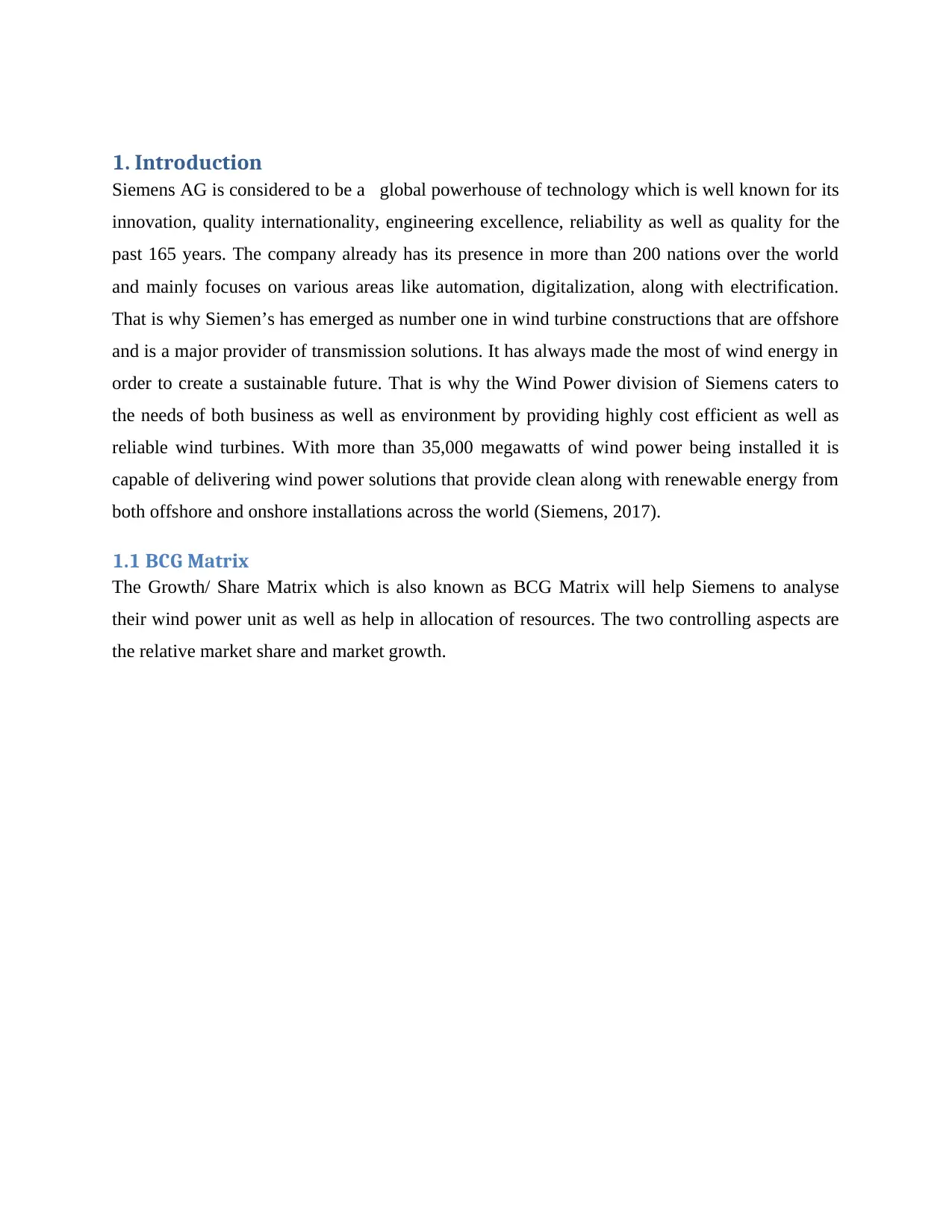
1. Introduction
Siemens AG is considered to be a global powerhouse of technology which is well known for its
innovation, quality internationality, engineering excellence, reliability as well as quality for the
past 165 years. The company already has its presence in more than 200 nations over the world
and mainly focuses on various areas like automation, digitalization, along with electrification.
That is why Siemen’s has emerged as number one in wind turbine constructions that are offshore
and is a major provider of transmission solutions. It has always made the most of wind energy in
order to create a sustainable future. That is why the Wind Power division of Siemens caters to
the needs of both business as well as environment by providing highly cost efficient as well as
reliable wind turbines. With more than 35,000 megawatts of wind power being installed it is
capable of delivering wind power solutions that provide clean along with renewable energy from
both offshore and onshore installations across the world (Siemens, 2017).
1.1 BCG Matrix
The Growth/ Share Matrix which is also known as BCG Matrix will help Siemens to analyse
their wind power unit as well as help in allocation of resources. The two controlling aspects are
the relative market share and market growth.
Siemens AG is considered to be a global powerhouse of technology which is well known for its
innovation, quality internationality, engineering excellence, reliability as well as quality for the
past 165 years. The company already has its presence in more than 200 nations over the world
and mainly focuses on various areas like automation, digitalization, along with electrification.
That is why Siemen’s has emerged as number one in wind turbine constructions that are offshore
and is a major provider of transmission solutions. It has always made the most of wind energy in
order to create a sustainable future. That is why the Wind Power division of Siemens caters to
the needs of both business as well as environment by providing highly cost efficient as well as
reliable wind turbines. With more than 35,000 megawatts of wind power being installed it is
capable of delivering wind power solutions that provide clean along with renewable energy from
both offshore and onshore installations across the world (Siemens, 2017).
1.1 BCG Matrix
The Growth/ Share Matrix which is also known as BCG Matrix will help Siemens to analyse
their wind power unit as well as help in allocation of resources. The two controlling aspects are
the relative market share and market growth.
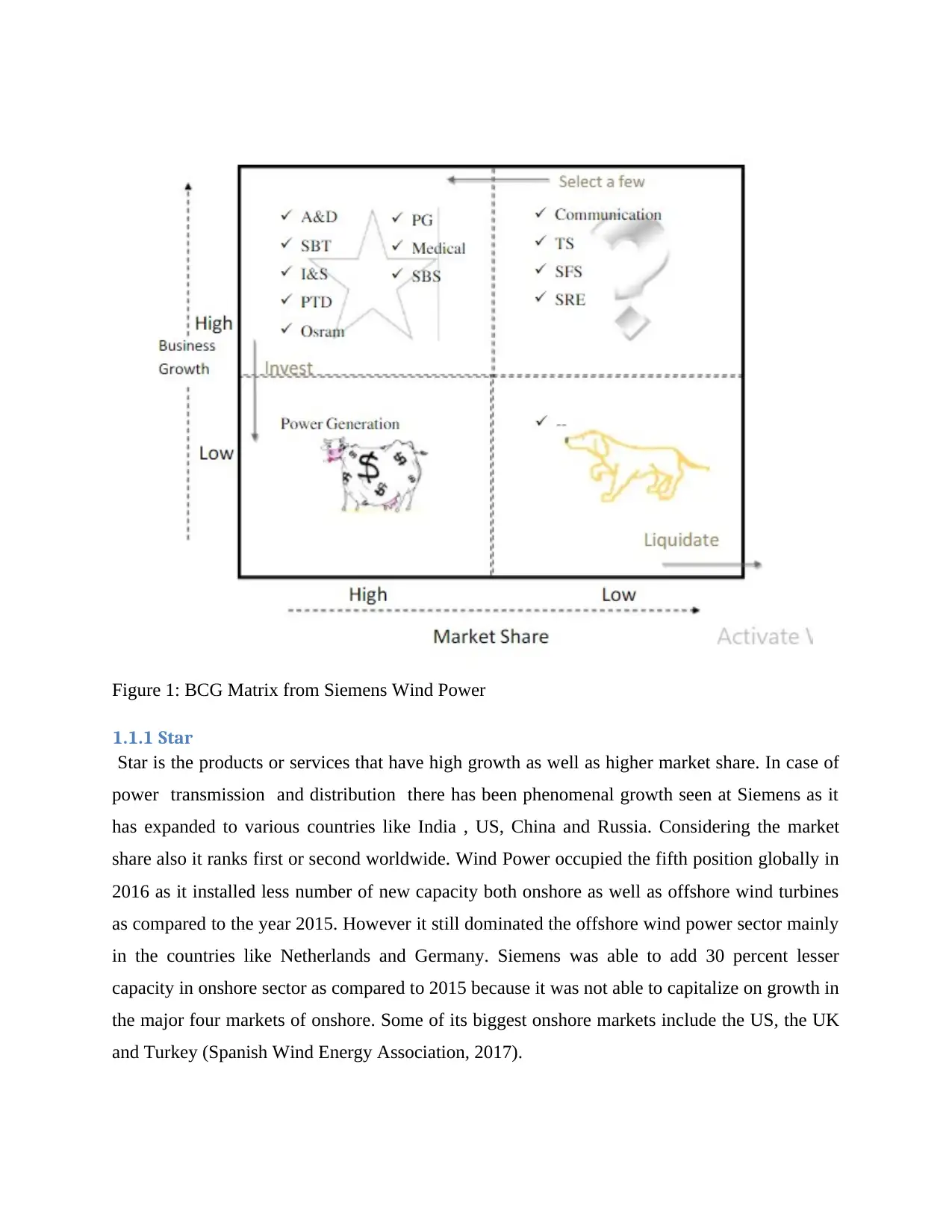
Figure 1: BCG Matrix from Siemens Wind Power
1.1.1 Star
Star is the products or services that have high growth as well as higher market share. In case of
power transmission and distribution there has been phenomenal growth seen at Siemens as it
has expanded to various countries like India , US, China and Russia. Considering the market
share also it ranks first or second worldwide. Wind Power occupied the fifth position globally in
2016 as it installed less number of new capacity both onshore as well as offshore wind turbines
as compared to the year 2015. However it still dominated the offshore wind power sector mainly
in the countries like Netherlands and Germany. Siemens was able to add 30 percent lesser
capacity in onshore sector as compared to 2015 because it was not able to capitalize on growth in
the major four markets of onshore. Some of its biggest onshore markets include the US, the UK
and Turkey (Spanish Wind Energy Association, 2017).
1.1.1 Star
Star is the products or services that have high growth as well as higher market share. In case of
power transmission and distribution there has been phenomenal growth seen at Siemens as it
has expanded to various countries like India , US, China and Russia. Considering the market
share also it ranks first or second worldwide. Wind Power occupied the fifth position globally in
2016 as it installed less number of new capacity both onshore as well as offshore wind turbines
as compared to the year 2015. However it still dominated the offshore wind power sector mainly
in the countries like Netherlands and Germany. Siemens was able to add 30 percent lesser
capacity in onshore sector as compared to 2015 because it was not able to capitalize on growth in
the major four markets of onshore. Some of its biggest onshore markets include the US, the UK
and Turkey (Spanish Wind Energy Association, 2017).
⊘ This is a preview!⊘
Do you want full access?
Subscribe today to unlock all pages.

Trusted by 1+ million students worldwide
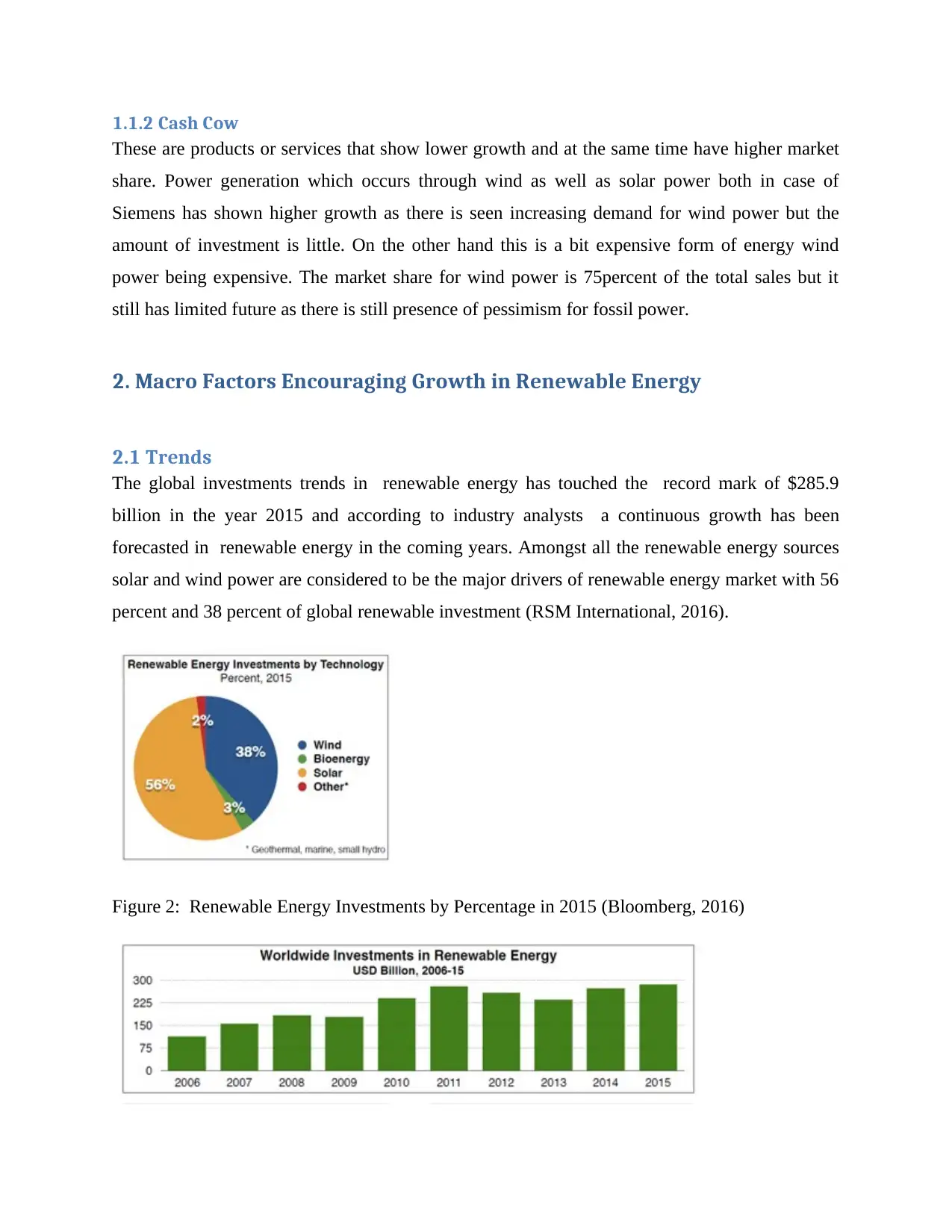
1.1.2 Cash Cow
These are products or services that show lower growth and at the same time have higher market
share. Power generation which occurs through wind as well as solar power both in case of
Siemens has shown higher growth as there is seen increasing demand for wind power but the
amount of investment is little. On the other hand this is a bit expensive form of energy wind
power being expensive. The market share for wind power is 75percent of the total sales but it
still has limited future as there is still presence of pessimism for fossil power.
2. Macro Factors Encouraging Growth in Renewable Energy
2.1 Trends
The global investments trends in renewable energy has touched the record mark of $285.9
billion in the year 2015 and according to industry analysts a continuous growth has been
forecasted in renewable energy in the coming years. Amongst all the renewable energy sources
solar and wind power are considered to be the major drivers of renewable energy market with 56
percent and 38 percent of global renewable investment (RSM International, 2016).
Figure 2: Renewable Energy Investments by Percentage in 2015 (Bloomberg, 2016)
These are products or services that show lower growth and at the same time have higher market
share. Power generation which occurs through wind as well as solar power both in case of
Siemens has shown higher growth as there is seen increasing demand for wind power but the
amount of investment is little. On the other hand this is a bit expensive form of energy wind
power being expensive. The market share for wind power is 75percent of the total sales but it
still has limited future as there is still presence of pessimism for fossil power.
2. Macro Factors Encouraging Growth in Renewable Energy
2.1 Trends
The global investments trends in renewable energy has touched the record mark of $285.9
billion in the year 2015 and according to industry analysts a continuous growth has been
forecasted in renewable energy in the coming years. Amongst all the renewable energy sources
solar and wind power are considered to be the major drivers of renewable energy market with 56
percent and 38 percent of global renewable investment (RSM International, 2016).
Figure 2: Renewable Energy Investments by Percentage in 2015 (Bloomberg, 2016)
Paraphrase This Document
Need a fresh take? Get an instant paraphrase of this document with our AI Paraphraser
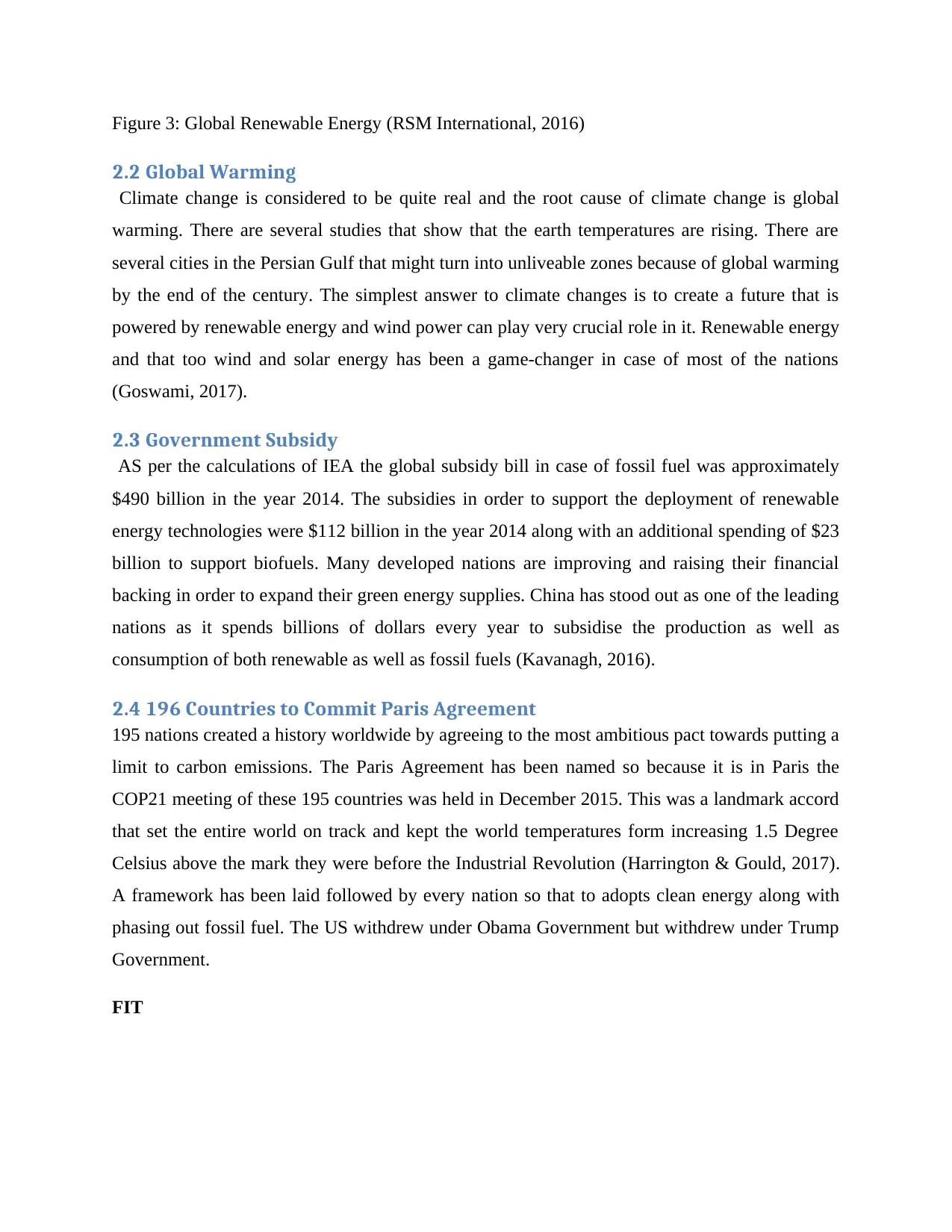
Figure 3: Global Renewable Energy (RSM International, 2016)
2.2 Global Warming
Climate change is considered to be quite real and the root cause of climate change is global
warming. There are several studies that show that the earth temperatures are rising. There are
several cities in the Persian Gulf that might turn into unliveable zones because of global warming
by the end of the century. The simplest answer to climate changes is to create a future that is
powered by renewable energy and wind power can play very crucial role in it. Renewable energy
and that too wind and solar energy has been a game-changer in case of most of the nations
(Goswami, 2017).
2.3 Government Subsidy
AS per the calculations of IEA the global subsidy bill in case of fossil fuel was approximately
$490 billion in the year 2014. The subsidies in order to support the deployment of renewable
energy technologies were $112 billion in the year 2014 along with an additional spending of $23
billion to support biofuels. Many developed nations are improving and raising their financial
backing in order to expand their green energy supplies. China has stood out as one of the leading
nations as it spends billions of dollars every year to subsidise the production as well as
consumption of both renewable as well as fossil fuels (Kavanagh, 2016).
2.4 196 Countries to Commit Paris Agreement
195 nations created a history worldwide by agreeing to the most ambitious pact towards putting a
limit to carbon emissions. The Paris Agreement has been named so because it is in Paris the
COP21 meeting of these 195 countries was held in December 2015. This was a landmark accord
that set the entire world on track and kept the world temperatures form increasing 1.5 Degree
Celsius above the mark they were before the Industrial Revolution (Harrington & Gould, 2017).
A framework has been laid followed by every nation so that to adopts clean energy along with
phasing out fossil fuel. The US withdrew under Obama Government but withdrew under Trump
Government.
FIT
2.2 Global Warming
Climate change is considered to be quite real and the root cause of climate change is global
warming. There are several studies that show that the earth temperatures are rising. There are
several cities in the Persian Gulf that might turn into unliveable zones because of global warming
by the end of the century. The simplest answer to climate changes is to create a future that is
powered by renewable energy and wind power can play very crucial role in it. Renewable energy
and that too wind and solar energy has been a game-changer in case of most of the nations
(Goswami, 2017).
2.3 Government Subsidy
AS per the calculations of IEA the global subsidy bill in case of fossil fuel was approximately
$490 billion in the year 2014. The subsidies in order to support the deployment of renewable
energy technologies were $112 billion in the year 2014 along with an additional spending of $23
billion to support biofuels. Many developed nations are improving and raising their financial
backing in order to expand their green energy supplies. China has stood out as one of the leading
nations as it spends billions of dollars every year to subsidise the production as well as
consumption of both renewable as well as fossil fuels (Kavanagh, 2016).
2.4 196 Countries to Commit Paris Agreement
195 nations created a history worldwide by agreeing to the most ambitious pact towards putting a
limit to carbon emissions. The Paris Agreement has been named so because it is in Paris the
COP21 meeting of these 195 countries was held in December 2015. This was a landmark accord
that set the entire world on track and kept the world temperatures form increasing 1.5 Degree
Celsius above the mark they were before the Industrial Revolution (Harrington & Gould, 2017).
A framework has been laid followed by every nation so that to adopts clean energy along with
phasing out fossil fuel. The US withdrew under Obama Government but withdrew under Trump
Government.
FIT
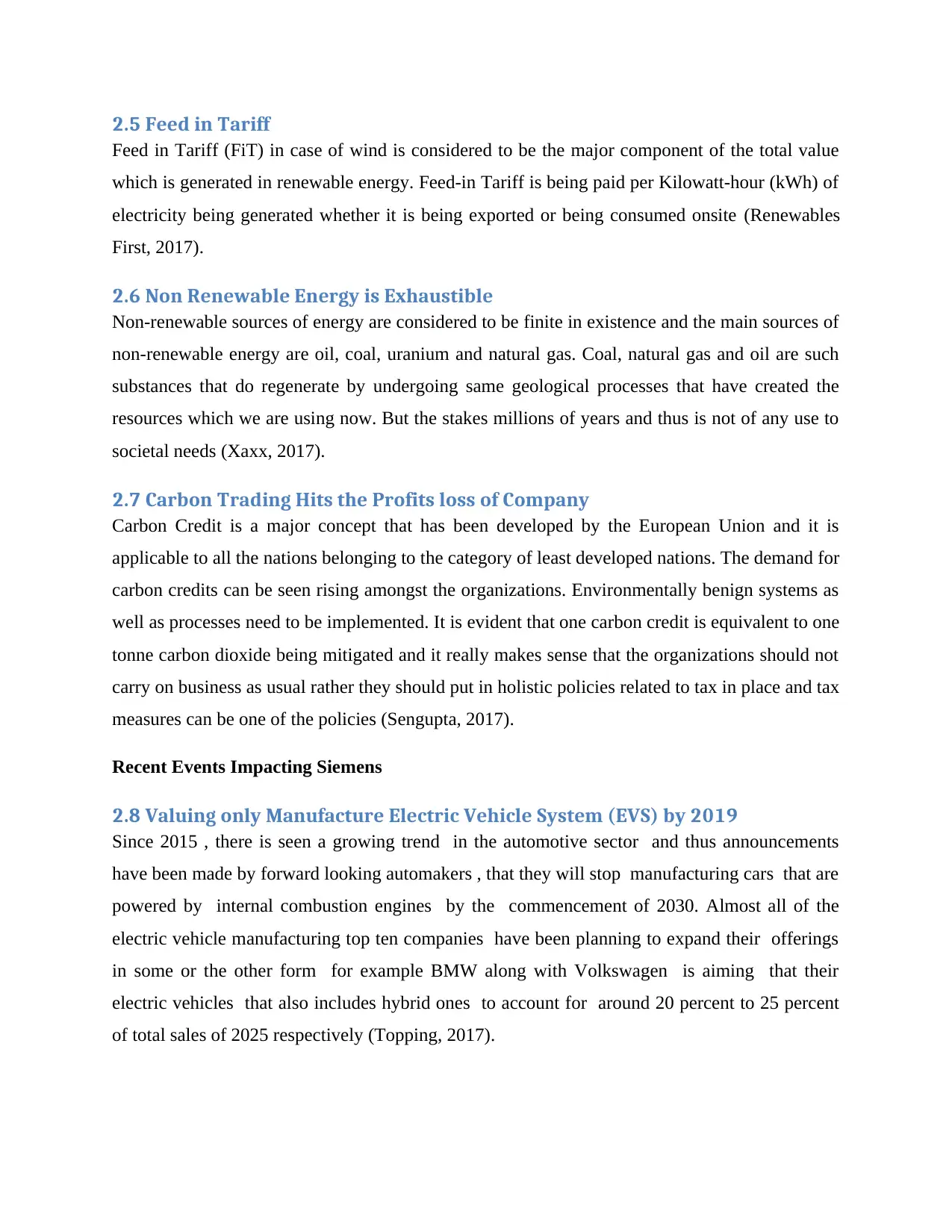
2.5 Feed in Tariff
Feed in Tariff (FiT) in case of wind is considered to be the major component of the total value
which is generated in renewable energy. Feed-in Tariff is being paid per Kilowatt-hour (kWh) of
electricity being generated whether it is being exported or being consumed onsite (Renewables
First, 2017).
2.6 Non Renewable Energy is Exhaustible
Non-renewable sources of energy are considered to be finite in existence and the main sources of
non-renewable energy are oil, coal, uranium and natural gas. Coal, natural gas and oil are such
substances that do regenerate by undergoing same geological processes that have created the
resources which we are using now. But the stakes millions of years and thus is not of any use to
societal needs (Xaxx, 2017).
2.7 Carbon Trading Hits the Profits loss of Company
Carbon Credit is a major concept that has been developed by the European Union and it is
applicable to all the nations belonging to the category of least developed nations. The demand for
carbon credits can be seen rising amongst the organizations. Environmentally benign systems as
well as processes need to be implemented. It is evident that one carbon credit is equivalent to one
tonne carbon dioxide being mitigated and it really makes sense that the organizations should not
carry on business as usual rather they should put in holistic policies related to tax in place and tax
measures can be one of the policies (Sengupta, 2017).
Recent Events Impacting Siemens
2.8 Valuing only Manufacture Electric Vehicle System (EVS) by 2019
Since 2015 , there is seen a growing trend in the automotive sector and thus announcements
have been made by forward looking automakers , that they will stop manufacturing cars that are
powered by internal combustion engines by the commencement of 2030. Almost all of the
electric vehicle manufacturing top ten companies have been planning to expand their offerings
in some or the other form for example BMW along with Volkswagen is aiming that their
electric vehicles that also includes hybrid ones to account for around 20 percent to 25 percent
of total sales of 2025 respectively (Topping, 2017).
Feed in Tariff (FiT) in case of wind is considered to be the major component of the total value
which is generated in renewable energy. Feed-in Tariff is being paid per Kilowatt-hour (kWh) of
electricity being generated whether it is being exported or being consumed onsite (Renewables
First, 2017).
2.6 Non Renewable Energy is Exhaustible
Non-renewable sources of energy are considered to be finite in existence and the main sources of
non-renewable energy are oil, coal, uranium and natural gas. Coal, natural gas and oil are such
substances that do regenerate by undergoing same geological processes that have created the
resources which we are using now. But the stakes millions of years and thus is not of any use to
societal needs (Xaxx, 2017).
2.7 Carbon Trading Hits the Profits loss of Company
Carbon Credit is a major concept that has been developed by the European Union and it is
applicable to all the nations belonging to the category of least developed nations. The demand for
carbon credits can be seen rising amongst the organizations. Environmentally benign systems as
well as processes need to be implemented. It is evident that one carbon credit is equivalent to one
tonne carbon dioxide being mitigated and it really makes sense that the organizations should not
carry on business as usual rather they should put in holistic policies related to tax in place and tax
measures can be one of the policies (Sengupta, 2017).
Recent Events Impacting Siemens
2.8 Valuing only Manufacture Electric Vehicle System (EVS) by 2019
Since 2015 , there is seen a growing trend in the automotive sector and thus announcements
have been made by forward looking automakers , that they will stop manufacturing cars that are
powered by internal combustion engines by the commencement of 2030. Almost all of the
electric vehicle manufacturing top ten companies have been planning to expand their offerings
in some or the other form for example BMW along with Volkswagen is aiming that their
electric vehicles that also includes hybrid ones to account for around 20 percent to 25 percent
of total sales of 2025 respectively (Topping, 2017).
⊘ This is a preview!⊘
Do you want full access?
Subscribe today to unlock all pages.

Trusted by 1+ million students worldwide
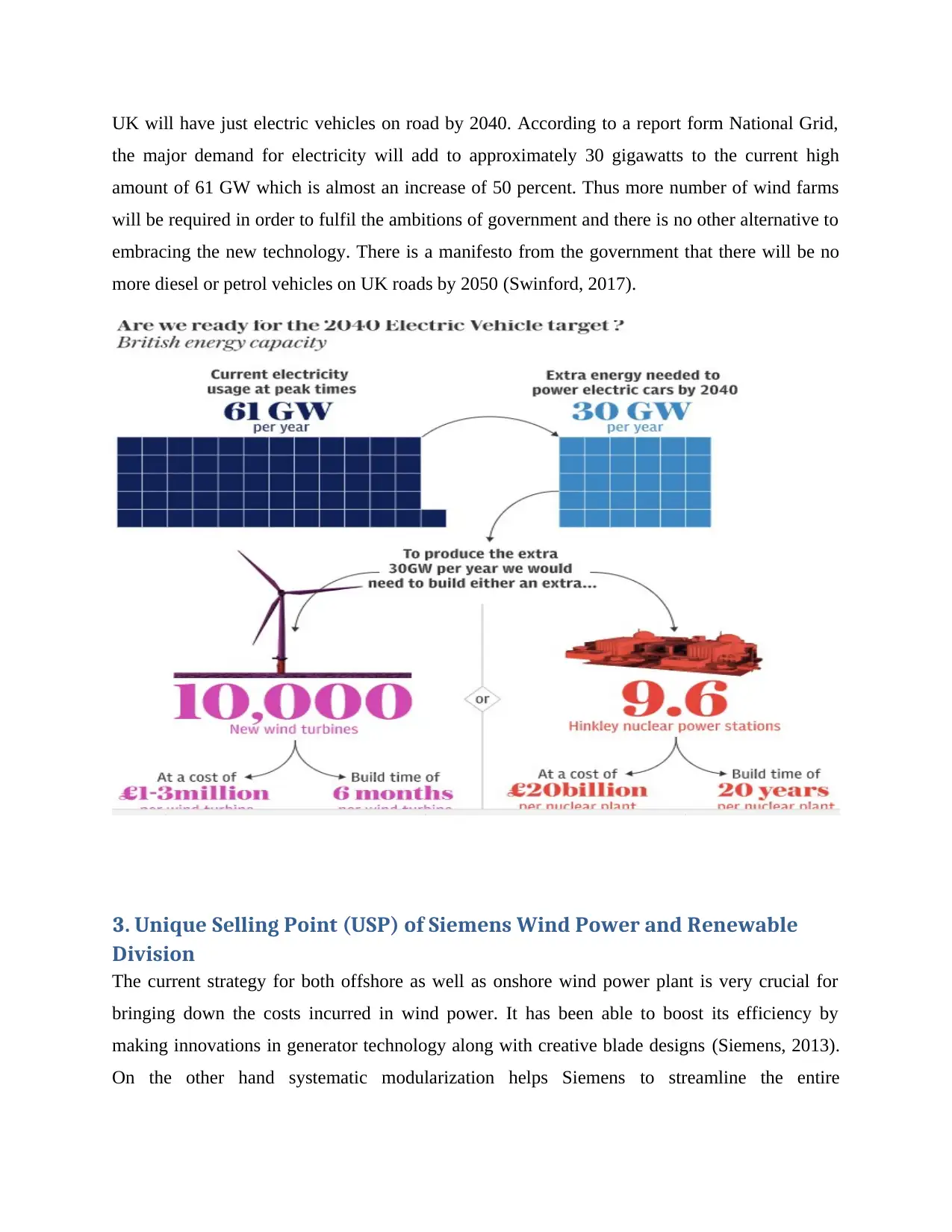
UK will have just electric vehicles on road by 2040. According to a report form National Grid,
the major demand for electricity will add to approximately 30 gigawatts to the current high
amount of 61 GW which is almost an increase of 50 percent. Thus more number of wind farms
will be required in order to fulfil the ambitions of government and there is no other alternative to
embracing the new technology. There is a manifesto from the government that there will be no
more diesel or petrol vehicles on UK roads by 2050 (Swinford, 2017).
3. Unique Selling Point (USP) of Siemens Wind Power and Renewable
Division
The current strategy for both offshore as well as onshore wind power plant is very crucial for
bringing down the costs incurred in wind power. It has been able to boost its efficiency by
making innovations in generator technology along with creative blade designs (Siemens, 2013).
On the other hand systematic modularization helps Siemens to streamline the entire
the major demand for electricity will add to approximately 30 gigawatts to the current high
amount of 61 GW which is almost an increase of 50 percent. Thus more number of wind farms
will be required in order to fulfil the ambitions of government and there is no other alternative to
embracing the new technology. There is a manifesto from the government that there will be no
more diesel or petrol vehicles on UK roads by 2050 (Swinford, 2017).
3. Unique Selling Point (USP) of Siemens Wind Power and Renewable
Division
The current strategy for both offshore as well as onshore wind power plant is very crucial for
bringing down the costs incurred in wind power. It has been able to boost its efficiency by
making innovations in generator technology along with creative blade designs (Siemens, 2013).
On the other hand systematic modularization helps Siemens to streamline the entire
Paraphrase This Document
Need a fresh take? Get an instant paraphrase of this document with our AI Paraphraser
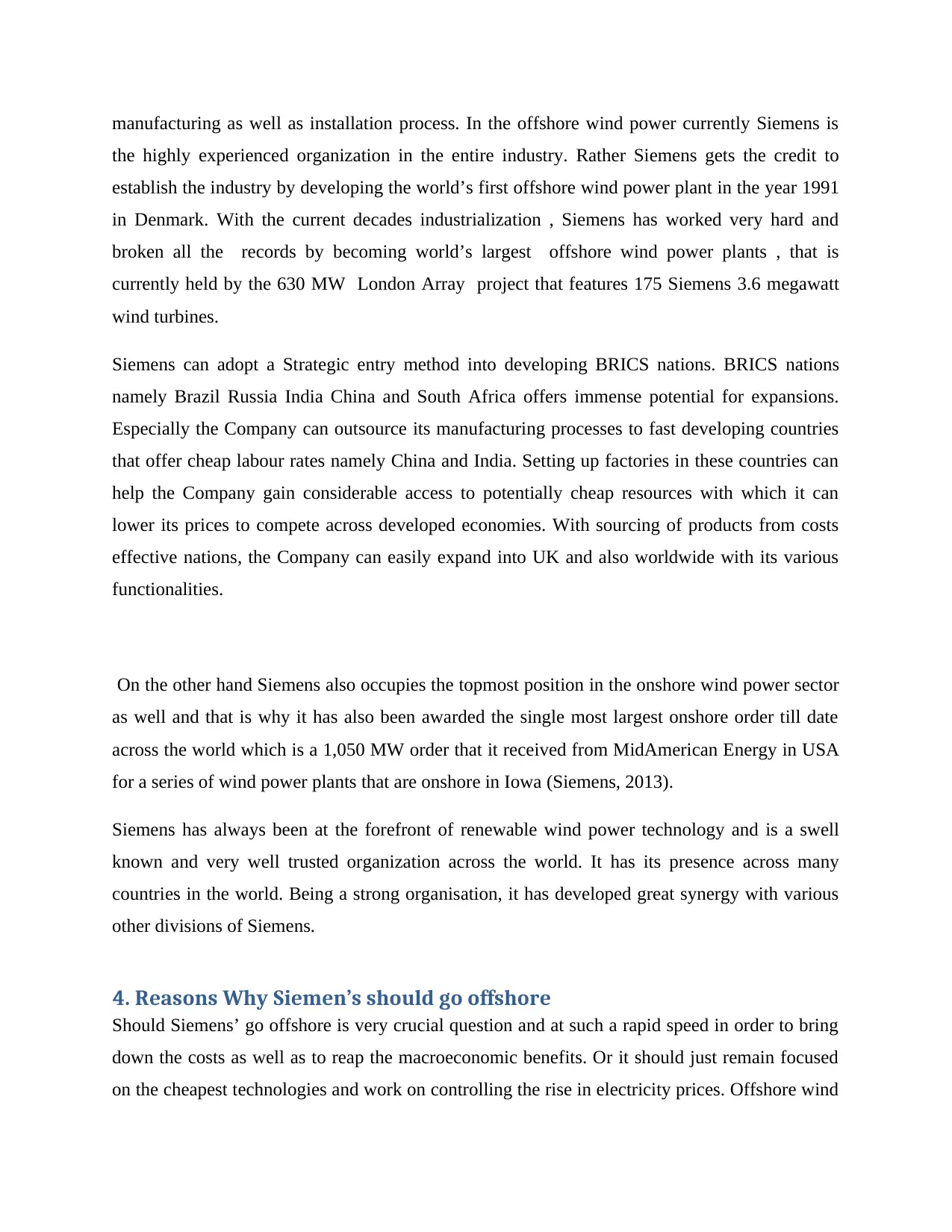
manufacturing as well as installation process. In the offshore wind power currently Siemens is
the highly experienced organization in the entire industry. Rather Siemens gets the credit to
establish the industry by developing the world’s first offshore wind power plant in the year 1991
in Denmark. With the current decades industrialization , Siemens has worked very hard and
broken all the records by becoming world’s largest offshore wind power plants , that is
currently held by the 630 MW London Array project that features 175 Siemens 3.6 megawatt
wind turbines.
Siemens can adopt a Strategic entry method into developing BRICS nations. BRICS nations
namely Brazil Russia India China and South Africa offers immense potential for expansions.
Especially the Company can outsource its manufacturing processes to fast developing countries
that offer cheap labour rates namely China and India. Setting up factories in these countries can
help the Company gain considerable access to potentially cheap resources with which it can
lower its prices to compete across developed economies. With sourcing of products from costs
effective nations, the Company can easily expand into UK and also worldwide with its various
functionalities.
On the other hand Siemens also occupies the topmost position in the onshore wind power sector
as well and that is why it has also been awarded the single most largest onshore order till date
across the world which is a 1,050 MW order that it received from MidAmerican Energy in USA
for a series of wind power plants that are onshore in Iowa (Siemens, 2013).
Siemens has always been at the forefront of renewable wind power technology and is a swell
known and very well trusted organization across the world. It has its presence across many
countries in the world. Being a strong organisation, it has developed great synergy with various
other divisions of Siemens.
4. Reasons Why Siemen’s should go offshore
Should Siemens’ go offshore is very crucial question and at such a rapid speed in order to bring
down the costs as well as to reap the macroeconomic benefits. Or it should just remain focused
on the cheapest technologies and work on controlling the rise in electricity prices. Offshore wind
the highly experienced organization in the entire industry. Rather Siemens gets the credit to
establish the industry by developing the world’s first offshore wind power plant in the year 1991
in Denmark. With the current decades industrialization , Siemens has worked very hard and
broken all the records by becoming world’s largest offshore wind power plants , that is
currently held by the 630 MW London Array project that features 175 Siemens 3.6 megawatt
wind turbines.
Siemens can adopt a Strategic entry method into developing BRICS nations. BRICS nations
namely Brazil Russia India China and South Africa offers immense potential for expansions.
Especially the Company can outsource its manufacturing processes to fast developing countries
that offer cheap labour rates namely China and India. Setting up factories in these countries can
help the Company gain considerable access to potentially cheap resources with which it can
lower its prices to compete across developed economies. With sourcing of products from costs
effective nations, the Company can easily expand into UK and also worldwide with its various
functionalities.
On the other hand Siemens also occupies the topmost position in the onshore wind power sector
as well and that is why it has also been awarded the single most largest onshore order till date
across the world which is a 1,050 MW order that it received from MidAmerican Energy in USA
for a series of wind power plants that are onshore in Iowa (Siemens, 2013).
Siemens has always been at the forefront of renewable wind power technology and is a swell
known and very well trusted organization across the world. It has its presence across many
countries in the world. Being a strong organisation, it has developed great synergy with various
other divisions of Siemens.
4. Reasons Why Siemen’s should go offshore
Should Siemens’ go offshore is very crucial question and at such a rapid speed in order to bring
down the costs as well as to reap the macroeconomic benefits. Or it should just remain focused
on the cheapest technologies and work on controlling the rise in electricity prices. Offshore wind
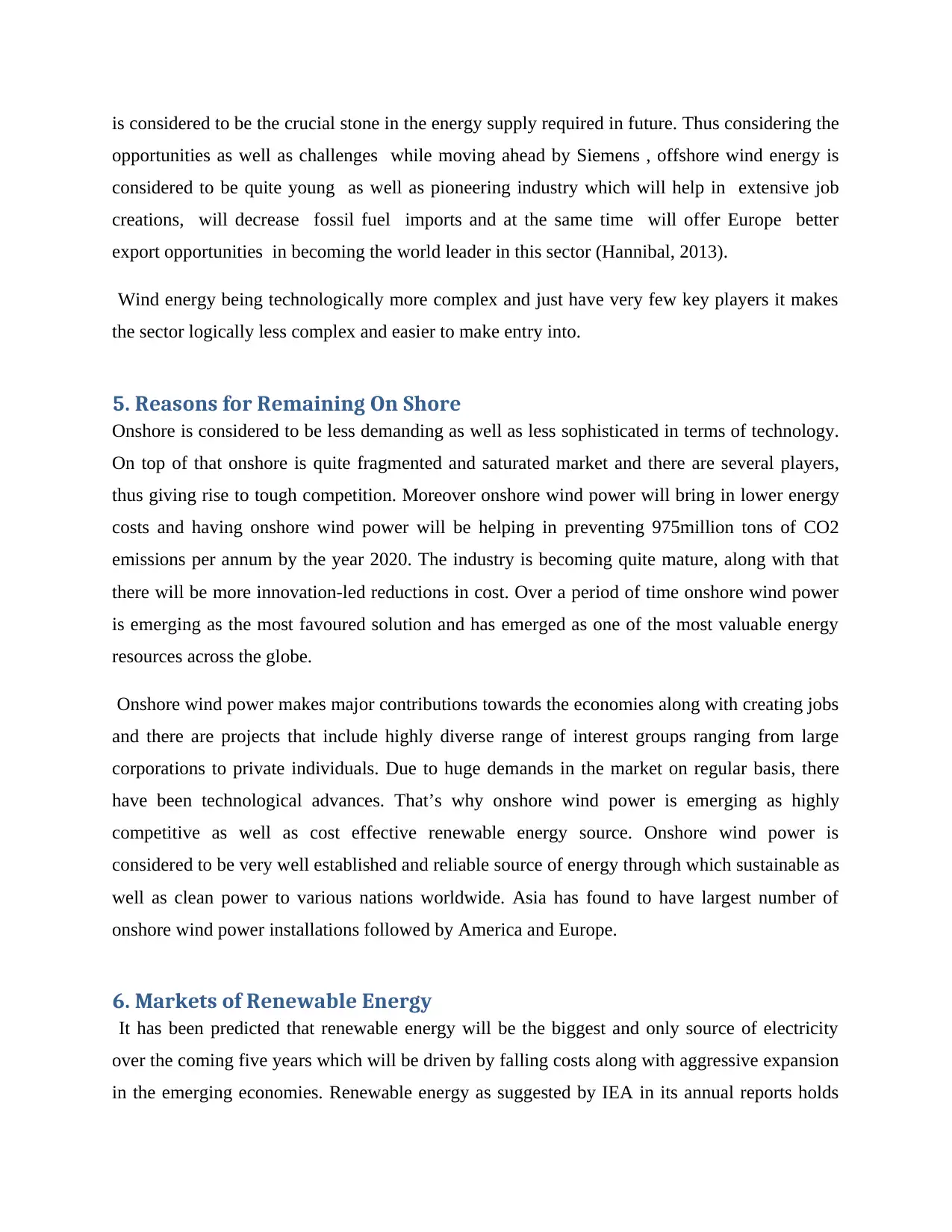
is considered to be the crucial stone in the energy supply required in future. Thus considering the
opportunities as well as challenges while moving ahead by Siemens , offshore wind energy is
considered to be quite young as well as pioneering industry which will help in extensive job
creations, will decrease fossil fuel imports and at the same time will offer Europe better
export opportunities in becoming the world leader in this sector (Hannibal, 2013).
Wind energy being technologically more complex and just have very few key players it makes
the sector logically less complex and easier to make entry into.
5. Reasons for Remaining On Shore
Onshore is considered to be less demanding as well as less sophisticated in terms of technology.
On top of that onshore is quite fragmented and saturated market and there are several players,
thus giving rise to tough competition. Moreover onshore wind power will bring in lower energy
costs and having onshore wind power will be helping in preventing 975million tons of CO2
emissions per annum by the year 2020. The industry is becoming quite mature, along with that
there will be more innovation-led reductions in cost. Over a period of time onshore wind power
is emerging as the most favoured solution and has emerged as one of the most valuable energy
resources across the globe.
Onshore wind power makes major contributions towards the economies along with creating jobs
and there are projects that include highly diverse range of interest groups ranging from large
corporations to private individuals. Due to huge demands in the market on regular basis, there
have been technological advances. That’s why onshore wind power is emerging as highly
competitive as well as cost effective renewable energy source. Onshore wind power is
considered to be very well established and reliable source of energy through which sustainable as
well as clean power to various nations worldwide. Asia has found to have largest number of
onshore wind power installations followed by America and Europe.
6. Markets of Renewable Energy
It has been predicted that renewable energy will be the biggest and only source of electricity
over the coming five years which will be driven by falling costs along with aggressive expansion
in the emerging economies. Renewable energy as suggested by IEA in its annual reports holds
opportunities as well as challenges while moving ahead by Siemens , offshore wind energy is
considered to be quite young as well as pioneering industry which will help in extensive job
creations, will decrease fossil fuel imports and at the same time will offer Europe better
export opportunities in becoming the world leader in this sector (Hannibal, 2013).
Wind energy being technologically more complex and just have very few key players it makes
the sector logically less complex and easier to make entry into.
5. Reasons for Remaining On Shore
Onshore is considered to be less demanding as well as less sophisticated in terms of technology.
On top of that onshore is quite fragmented and saturated market and there are several players,
thus giving rise to tough competition. Moreover onshore wind power will bring in lower energy
costs and having onshore wind power will be helping in preventing 975million tons of CO2
emissions per annum by the year 2020. The industry is becoming quite mature, along with that
there will be more innovation-led reductions in cost. Over a period of time onshore wind power
is emerging as the most favoured solution and has emerged as one of the most valuable energy
resources across the globe.
Onshore wind power makes major contributions towards the economies along with creating jobs
and there are projects that include highly diverse range of interest groups ranging from large
corporations to private individuals. Due to huge demands in the market on regular basis, there
have been technological advances. That’s why onshore wind power is emerging as highly
competitive as well as cost effective renewable energy source. Onshore wind power is
considered to be very well established and reliable source of energy through which sustainable as
well as clean power to various nations worldwide. Asia has found to have largest number of
onshore wind power installations followed by America and Europe.
6. Markets of Renewable Energy
It has been predicted that renewable energy will be the biggest and only source of electricity
over the coming five years which will be driven by falling costs along with aggressive expansion
in the emerging economies. Renewable energy as suggested by IEA in its annual reports holds
⊘ This is a preview!⊘
Do you want full access?
Subscribe today to unlock all pages.

Trusted by 1+ million students worldwide
1 out of 20
Related Documents
Your All-in-One AI-Powered Toolkit for Academic Success.
+13062052269
info@desklib.com
Available 24*7 on WhatsApp / Email
![[object Object]](/_next/static/media/star-bottom.7253800d.svg)
Unlock your academic potential
Copyright © 2020–2025 A2Z Services. All Rights Reserved. Developed and managed by ZUCOL.





